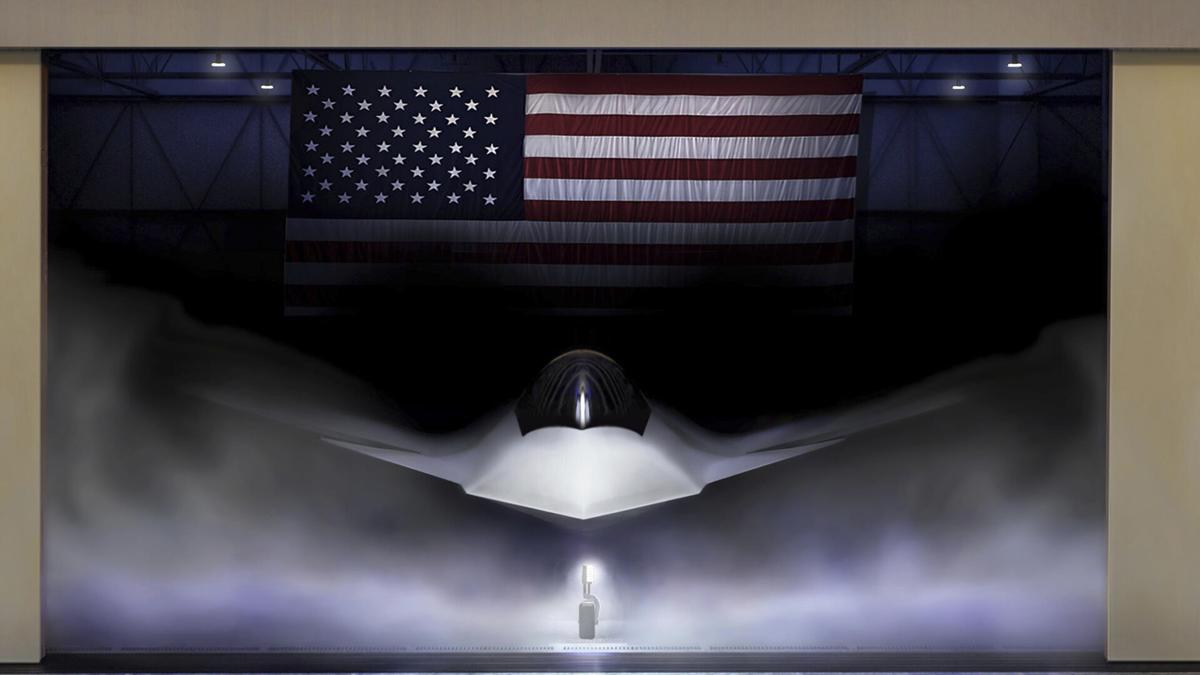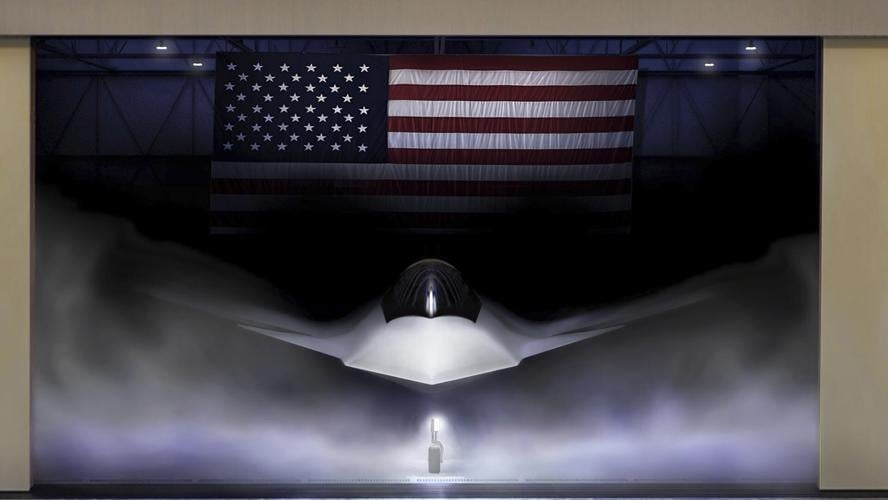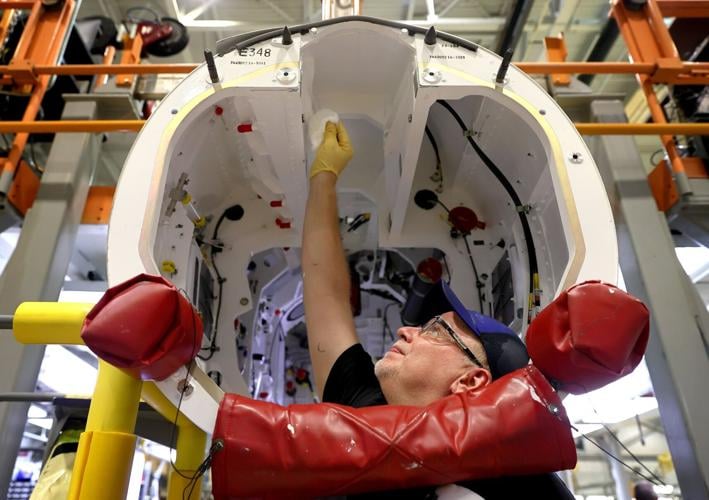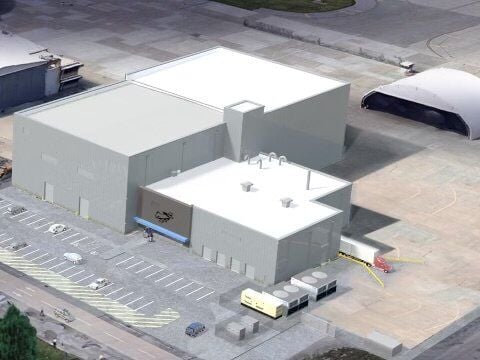ST. LOUIS — The Boeing Co.’s $20 billion contract to build the next generation of fighter planes could bring thousands of jobs to the region and secure the future of the defense industry here.
But it hinges on details that are, so far, unclear. How much of the work will happen in St. Louis? Will Boeing hire for the project or shift jobs? How much demand will there be for manned aircraft in the future?
Ecstatic public officials in Missouri lauded each other and President Donald Trump late last week after he announced Boeing will build the nation’s next-generation fighter jet.
Their enthusiasm is warranted, analysts say. The aerospace company’s future in the St. Louis region was uncharted but the new contract, worth $20 billion to start, secures a place for another generation of Boeing workers who will build the F-47.
People are also reading…
“This is the best news that Boeing St. Louis has gotten in the current century,” said Loren Thompson, a longtime aerospace analyst.
Boeing’s more than 16,000 employees in the region are well positioned for the work. They’ve built other fighter jets, including the F-15 and F/A-18, and they’ve been working on government defense contracts for decades.

A worker cleans the inside of the nose barrel on the forward section of a Boeing F/A-18 Super Hornet fighter jet at the St. Louis assembly line on Aug. 10, 2022.
Experts say the new contract will bring years more work to the region and hundreds, if not thousands, of jobs. And that would be a huge boon to the region, where leaders have been fighting for decades to keep afloat the aerospace industry — a pillar of the local economy. Officials across the region, from local governments to community college training programs, are already preparing for the impact.
“This is a generational impact. Their presence here is immense,” said Maggie Kost, who works to attract companies to the region with the business group Greater St. Louis Inc. “It cements us as a defense hub nationally, and it’s certainly, beyond just our regional economy, going to have incredible implications for our national security.”
Others are uncertain of the impact the deal will have on the St. Louis region.
Boeing won’t say if it’s hiring here, bringing employees in from elsewhere, or even shifting workers to the new jobs. One of the president’s closest advisers has said it’s time to phase out manned aircraft, such as the F-47. The Air Force has scaled back big fighter jet contracts before. Boeing is still recovering from crises in its business operations. And Secretary of Defense Pete Hegseth last month in military budget cuts for 2026.
“That creates serious headwinds for the program,” said Richard Aboulafia, an aerospace analyst with Ann Arbor, Michigan-based AeroDynamic Advisory. “Existing programs tend to get favored in that kind of budget environment.”
Boeing declined to comment.
Preparing now for jobs
When Boeing lost a contract in 2001 to build the Joint Strike Fighter, it set the tone for the next few decades.
The company lost other government competitions. Even some of the contracts it won didn’t make it any money, Thompson said. The cost of the company’s KC-46 tanker program, for instance, ran $7 billion over the contracted price.
There were other problems.
Crashes of the Boeing 737 Max killed hundreds of people and caused deep troubles in its commercial side. Delays in an Air Force One program — which builds jets for the U.S. president — have . A capsule Boeing built for NASA had problems with thrusters on its first mission to the international space station. And in September, of its defense, space and security division.
Boeing badly needed to win a significant fighter award, Thompson said.
The company invested heavily in the St. Louis region to qualify, said Kost, of Greater St. Louis. She recalls meeting with Boeing officials in early 2022, when she was still working for the Missouri Department of Economic Development.
“They said, ‘We’re going to need some help and we’re going after a big contract ... and we need to be ready,’” Kost said. “We set to work right from that moment to make sure that we could support them.”

A Frontier aircraft lands at St. Louis Lambert International Airport as demolition continues on an old aircraft manufacturing site on the north side of the property, used to produce World War II military planes by Curtiss-Wright and other aircraft for McDonnell-Douglas, on Friday, March 21, 2025. The 48-acre tract joins 110 acres in Berkeley leased to Boeing for expansion plans, including the new Phantom Works production plant near the Boeing executive offices.

A digital rendering of a new, secure, 47,500-square-foot Advanced Coatings Center that Boeing is building near St. Louis Lambert International Airport. The new facility will house post-assembly phases of production, operated by Phantom Works, which is Boeing Defense, Space & Security’s proprietary research, development and prototyping division.
Boeing has constructed new buildings, torn down old ones and is still working on its expansion, Kost said. President Trump said in a news conference last week that a lot of the necessary infrastructure has already been built.
“And that’s what Boeing’s been working on,” Kost said.
The award couldn’t have come soon enough. In November, the company said it would lay off some 700 people here, and more layoffs were expected. St. Louis Community College last year, citing a hiring freeze at the company.
Now, everything looks different. The company has apparently regained trust, the analysts said, with its biggest customer: the U.S. government. And the St. Louis officials imagine widespread economic impact from all those expected new aerospace jobs, as suppliers, restaurants, barbers, dry cleaners and others ramp up to serve newcomers.
The community college is ready to restart its training program, too, said the college’s chief operating officer, Hart Nelson.
The college has been working with Boeing for 18 years, outfitting students with advanced manufacturing skills. In April, it plans to open a new advanced manufacturing center, which will have space for the Boeing training program. Students who graduate from it start at $21 per hour at Boeing — or about $44,000 a year — plus a raise after six months, Nelson said.
“With this new award, we’re waiting to hear from Boeing about what their needs are going to be and what kind of changes might need to happen to the program,” Nelson said. “We’ll be here when they’re ready.”
Can Boeing deliver?
Boeing didn’t respond to questions about how much work on the F-47 will happen in the St. Louis area, though experts collectively assume assembly — putting together the plane itself — will happen in the region. It just makes sense, given the company’s investment here, Kost said.
But obstacles remain, including among Trump’s top staffers.
Hegseth, Trump’s defense secretary, last month ordered military officials to cut $50 billion from their budgets for fiscal year 2026, said Aboulafia, the aerospace analyst. The money will be redirected to pay for Trump’s priorities, including a planned “Golden Dome” missile defense system.
And one of the president’s closest advisers might not support the F-47. Elon Musk last year that “manned fighter jets are obsolete.”
“So much of what gets funded depends upon presidential whims,” Aboulafia said. “As long as Musk is parked directly next to Trump, that creates enormous headwinds.”
The Next Generation Air Dominance program will include unmanned aircraft to fly with the manned fighter, said Thompson, the longtime aerospace analyst. Plus, Trump and Hegseth for the program by personally announcing the award at a news conference last week.
Still, government plans tend to change with political winds, such as when the U.S. Air Force the number of F-22 fighter jets it bought from contractor Lockheed Martin in the early 2000s. Boeing also worked on that program.
And Boeing still has fundamental business problems, said Jim Hall, former chairman of the National Transportation Safety Board and a frequent Boeing critic. The company needs to show the problems with the 737 Max and delays on Air Force One don’t repeat themselves “when the security of our nation is at risk,” Hall said.
“They’ll have to prove it,” Hall said.
Others believe the results of the award will soon be seen in the St. Louis region. Trump said a prototype for the F-47 has been flying for years. A lot of the engineering and design work has already been done, Thompson said. That means production jobs in the region within a few years.
“The positive effects of winning this program will become apparent quite quickly,” Thompson said. “That means jobs and income for St. Louis.”
Recent high-profile aviation incidents have reignited concerns over airline safety, but does this mean flying has become more dangerous? While the risk of fatal crashes remains historically low, a troubling rise in near misses suggests growing safety challenges. Despite two alarming incidents in early 2024—a runway collision in Japan and a Boeing 737 Max 9 mid-air emergency—commercial aviation remains statistically safer than ever. In 2023, there were only two fatal crashes, both involving small domestic aircraft, with no deaths on international passenger jets. Compared to the 148 lives lost per hour in road accidents, flying remains the safest mode of transportation. However, a recent investigation by The New York Times found that near misses between aircraft are occurring more frequently, particularly on runways. In a single year, the FAA recorded around 300 incidents where planes came dangerously close to colliding, some just seconds away from disaster. Notable cases include a private jet nearly striking a Southwest Airlines Boeing 737 in San Diego and a Southwest pilot aborting a landing to avoid a Delta aircraft in New Orleans. The rise in these incidents is partly due to increasing air traffic and human error in high-pressure airport environments. Runway incursions—where aircraft mistakenly enter active runways—have become a growing concern, with experts warning of “disturbing” global trends. Unlike mid-air accidents, which are rare, runway incidents have led to fatal crashes, such as the 2020 Pegasus Airlines disaster in Istanbul. Compounding these issues, turbulence has increased by 55% in the last 50 years due to climate change, making flights bumpier and posing injury risks. While turbulence itself doesn’t crash planes, severe jolts can throw unbelted passengers into the air. Air travel remains extraordinarily safe, but the increase in near misses and runway hazards highlights vulnerabilities in the system. Without continued vigilance, improved technology, and stricter safety protocols, these warning signs could lead to future disasters.


















